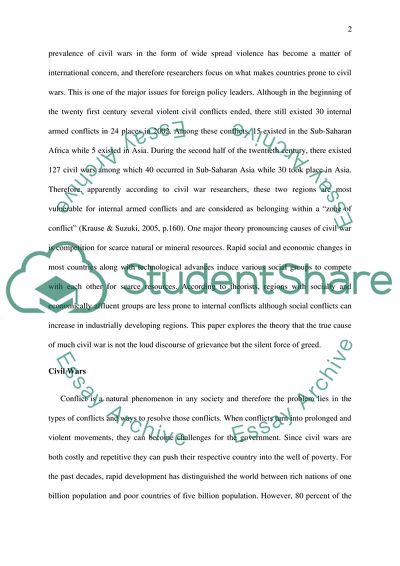Cite this document
(“Greed, not Grievance is the True Cause of Civil Wars Research Paper”, n.d.)
Greed, not Grievance is the True Cause of Civil Wars Research Paper. Retrieved from https://studentshare.org/politics/1635174-subjectinternational-politics-of-energy-resourcesessay-question7the-true-cause-of-much-civil-war-is-not-the-loud-discourse-of-grievance-but-the-silent-force-of-greed-collier-2000-critically-examine-this-claim-by-comparing-and-contrasting-two
Greed, not Grievance is the True Cause of Civil Wars Research Paper. Retrieved from https://studentshare.org/politics/1635174-subjectinternational-politics-of-energy-resourcesessay-question7the-true-cause-of-much-civil-war-is-not-the-loud-discourse-of-grievance-but-the-silent-force-of-greed-collier-2000-critically-examine-this-claim-by-comparing-and-contrasting-two
(Greed, Not Grievance Is the True Cause of Civil Wars Research Paper)
Greed, Not Grievance Is the True Cause of Civil Wars Research Paper. https://studentshare.org/politics/1635174-subjectinternational-politics-of-energy-resourcesessay-question7the-true-cause-of-much-civil-war-is-not-the-loud-discourse-of-grievance-but-the-silent-force-of-greed-collier-2000-critically-examine-this-claim-by-comparing-and-contrasting-two.
Greed, Not Grievance Is the True Cause of Civil Wars Research Paper. https://studentshare.org/politics/1635174-subjectinternational-politics-of-energy-resourcesessay-question7the-true-cause-of-much-civil-war-is-not-the-loud-discourse-of-grievance-but-the-silent-force-of-greed-collier-2000-critically-examine-this-claim-by-comparing-and-contrasting-two.
“Greed, Not Grievance Is the True Cause of Civil Wars Research Paper”, n.d. https://studentshare.org/politics/1635174-subjectinternational-politics-of-energy-resourcesessay-question7the-true-cause-of-much-civil-war-is-not-the-loud-discourse-of-grievance-but-the-silent-force-of-greed-collier-2000-critically-examine-this-claim-by-comparing-and-contrasting-two.


